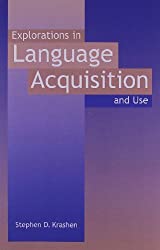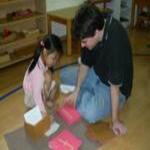Montessori and English as a Foreign Language (EFL)
by Matt Bronsil, author of English as a Foreign Language in the Montessori Classroom

According to APR Howatt and Richard Smith:
"Although lip-service was paid to the
importance of utilitarian objectives, the principal aim of most foreign language teaching in schools was typically literary, if only to deflect some of the criticism coming from the classicists that modern languages were 'soft options.'"
(Source: The History of Teaching English as a Foreign Language, from a British and European Perspective).
So how were Montessori's ideas different?
The July, 1913 edition of McClure's magazine has one of the first (and only) discussions on the subject of how Montessori would handle foreign language learning. The article was written by Ellen Yale Stevens, one of Montessori's earlier students who helped bring the Montessori Method of education to America. In it, she writes:
Dr. Montessori expresses herself as heartily in favor of young children learning a foreign language. She favors the direct conversational method, using games, songs, pictures, and charts. The material for sense-training could be explained in one language as well as another. The sandpaper and script alphabets could also be used, and the proper phonetic combinations given.
Dr. Montessori Expresses Herself as Heartily in Favor of
Young Children Learning a Foreign Language.
Young Children Learning a Foreign Language.
Montessori has written examples of how a child's absorbent mind works, often discussing how children can learn a 2nd, 3rd, or even 4th language more naturally than adults. So it stands to reason that Montessori would be in favor of teaching children foreign languages. This article is one of the few places we can find her ideas on the subject and that she thought this early in her career.
She Favors the Direct Conversational Method
A more direct method of teaching became popular around the late 1800s to early 1900s and was in response to the problem of grammatical and reading approach to language learning, which focused more on writing and grammar than speaking. The direct method uses only the target language, or the language the student will be learning. It also focuses on practicing conversation skills in the target language over the study of specific grammar skills or reading/writing. It does not ignore grammar and reading/writing, but it does not use it as its main basis for the language learning.
Montessori also suggested (at least according to Stevens) the use of "games, songs, pictures, and charts." The question of how to do that in a Montessori classroom is tricky. For a foreign language program, I fully support the idea of scheduled group circle times that happen outside the three hour work period.
Use of other Montessori materials
The answer Stevens mentioned only refers to the sensorial materials, sandpaper letters, and movable alphabet, but the entire classroom is full of opportunity to teach children the language:
✓ The practical life area should be filled with so many activities that the child can do both at school and at home, and think of all the names of objects you have in your house that you regularly use.
✓ The math materials go way beyond the normal 1-10 or 1-20 found in most preschool foreign language curriculums.
✓ Children are engaged in sink/float, magnetic/non-magnetic, living/non-living, classifying animals, and the entire science area.
✓ The sensorial materials really provide you with almost any adjective you can think of. Children also are able to follow directions easily in this area.
✓ The cultural area introduces students to different cultures in the world and allows them many opportunities to learn new ideas.
✓ Even if the child has mastered the language to the material, there are still things you can work on. Working with the Montessori materials is relaxing, so you have more chance to practice language you learned before or introduce new conversation topics.
To be a Montessori EFL teacher, you MUST get past the idea that your language will only happen when the children work with the language materials. The entire classroom is essentially an English learning environment (or whatever other language you are teaching).

See our $5 Webinar:
Montessori and English as a Foreign Language
Understanding the Goals of the Classroom
What is our main goal in the Montessori foreign language classroom? Is our goal to teach the language and push the students in the language? Or is it to help develop a more natural approach to language? With Montessori's ideas of development and education, I would suggest that to introduce a second or foreign language to the child, we would need to make it as natural as possible.
A very grassroots movement has started in language teaching that seeks to develop foreign and second language teaching based off a person's natural ability to learn languages. It is VERY different from what most of us adult readers went through in learning a different language. But let's begin with looking at what Maria Montessori observed with primary language development in children. Learn all you need to know from this book on amazon.
The most she wrote about this was in her book The Absorbent Mind. Chapter 11 is called "How Language Calls to the Child" and she outlines a detailed description of the process and ages where language skills tend to develop. (Note: This is not 100% accurate for EVERY SINGLE child who is still in the range of "normal" language. This may be VERY different for many children). Let's take a brief look at it:
👉 About 2 Months: Turn to the sound of a voice.
👉 4 Months: Focus intently on mouth of the person speaking.
👉 6 Months: First syllable that gets repeated.
👉 6-10 Months: Absorption of language. A lot more babbling.
👉 10 Months: Seems to show that language has a meaning to it.
👉 1 Year: First INTENTIONAL words start to be uttered.
👉 15 Months: Understands inflection, tone, and meaning behind words. Mimics words.
👉 18 Months: Starts to use noun words to identify with things.
👉 21 Months: Phrases of a few words.
👉 21 Months - 2 Years: Explosion of new words and phrases.
It goes on from there, but I'll stop to make a point. Imagine the frustration that would come from trying to get a 2 month old to repeat everything that you are saying. It won't happen. And even if you had the remote possibility of making it happen, how much retention would you expect?
Expectations of your students' language development in the new language should be similar. The time frame will be different, since they are not a newborn child. For example, it will generally take students less than 10 months to realize you are communicating with purposeful language, yet still, foreign and second language development happens in very similar stages to their first language. There is a lot of evidence to show that having students speak before they are ready is more harmful in the long run than helpful. There is good evidence to show pushing a child into any part of this learning process is more harmful than helpful. So let's look at stages you can expect in the beginning:
⛔ Totally ignoring you. Don't take this personally. It's just part of the process. But do get them to focus on you somehow.
👀 Begin to look at you as you talk.
👄 Focusing on your mouth while listening. A good way to do this is to hold the object up next to your mouth as you speak the word that goes with it. If they're naturally looking at the object, your mouth will be right next to it and they can easily see them both together.
👅 Begin to see you are speaking another language. I have had so many students stare at me, then start speaking in Taiwanese or Chinese. I really feel many of them have not learned I am speaking a different language.
🙄 Understand the tone with which you are speaking. Students do need time to understand your "keep trying" sound of your voice from your "stop throwing that material" voice. Some might think the serious voice is your joking voice and try to act on this. It is important to help them learn what you mean and when. This is where supportive co-workers come in. In the beginning at a school, some students might be angry with me because I don't let them run around during a lesson. If I try to make it stop, they might take it as me being silly and start laughing and getting more wound up. You NEED to put a stop to that or your whole year will be difficult. The staff who knows the language of the children can explain that when the teacher says, "Stop," you STOP! The children don't always understand the tone or voice inflection you are using. That makes it harder if they do not know the words. Once they understand this, life becomes easier, but this is one point you cannot roll over on in the beginning.
🙋 Start to name things. 3 part cards with students' pictures and names is very helpful here. It is something they hear regularly and can relate to. Learning the English names of students in the beginning offers a great way to get students to put names to what they are already familiar. Students will begin to progress at this stage at a rapid pace at times. They will want to participate in what you are doing more regularly.
As children progress through these, and later, stages, you will see them move from using gestures to communicate, to a few select key words. Then they will start using common phrases and expressions they hear regularly. Then they will begin to speak more freely. Some students move through this very quickly, while others take more time. But as you look back and remember where the students were before, you'll really begin to see signs of improvement that happened more quickly than you realized.
It is imperative to understand these phases of development in the 2nd language. If you understand that a child is not speaking because he or she is not ready, it helps you to provide that child with more opportunities for input in the language. If you understand that a child is not paying much attention to you, you can start to focus their attention more into what you are saying and work on a lot of TPR with the child so the child understands more. Without a clear understanding of these stages, you may push a child into something he or she is not ready for.

See our $5 Webinar:
Montessori and English as a Foreign Language
I mention tips of what to do with new students
Affective Filter
If you are like the majority of people in America, you had some form of foreign language in high school. Most would describe that experience as one of the worst experiences of your high school academic career. Most people understand the simple point that learning a language is often difficult, but there are many reasons for this to happen. It could be anxiety. It might be fear. It might be a lack of confidence. We have built into ourselves what we call an "affective filter." This is an imaginary filter that the input we receive from the language goes through before we acquire it. When the affective filter is high due to a number of possible reasons, the person has a hard time learning a language. When it is low, the person more easily learns and understands the target language, thus acquiring it more effectively.
Stephen Krashen is a professor emeritus at the University of Southern California. He argues that we have a number of psychological factors that filter how much a person learning a second language acquires. Much like how an air filter in your car keeps out the amount of dirt getting into your car's engine, the affective filter filters out language from being acquired. The filters can be anxiety, stress, fear, or anything else that slows down or even stops this acquisition. While there are countless factors that contribute to this, let's look at 3 things about Montessori that help lower the children's affective filter so they more readily acquire a language:
Motivation:
In a Montessori EFL or ESL setting, we can break down motivation into at least 2 factors: motivation to interact with you (the teacher) and motivation to interact with the environment/materials.
Motivation to interact with you comes naturally and, the more motivated they are to interact, the more they will keep finding opportunities to communicate with you. This motivation will come through after numerous positive interactions with you. Remember that patience is the key here. If a 3 year old is stressed when you are near her because you are that "strange sounding person" she doesn't know yet because you are speaking a language she knows nothing about, give her time to warm up to you first before you start shoving English presentations down her throat.
The materials will also become a motivating factor for the students. The nice thing about a Montessori classroom is that the child will automatically be choosing his or her own activities. So the child will naturally be interested and motivated in the work they are doing. Now, you will just have to help them learn the language with the materials.
Self-Confidence:
When adults meet a child that is reading at a young age, they often ask the child how they learned to read. Most people would give a similar answer: "My teacher (or mom, dad, grandmother, older brother....) taught me." When you ask a Montessori student, most will look at you strangely and say, "I taught myself."
One day in the classroom, a boy, age 3, kept trying to match up the sandpaper numerals with each other. There was a problem, though, the 9 was upside down and looked like a second 6. So after he matched up 0-8, he came to me to report a problem. "There are two sixes," he said. I confirmed it did indeed seem strange, but didn't tell him what to do. He put it where the six goes, trading it out for the six that was there, but then he was stuck with the same problem: he still had the second six. He eventually put it away. Then next day, he got it out again, but I made sure in the morning that the 9 was upside down again. He still had the same problem. After 3 days, he finally got it. He turned the second 6 upside down and it became a 9. He discovered what he did. His face beamed and he rushed over to me to show the new discovery that he had made.
Imagine if it had played out differently. Imagine if I simply just told him to turn it over. There was a good chance he could have learned it well, but that was not what I was aiming for. I wanted him to own the learning experience. In a Montessori setting, students own the learning they are actively doing in the classroom. Children also have a larger control of what they chose to do, thus deciding things that are more on their level. By the time they finish their 3-6 classroom experience, they should have a lot of self-confidence in their learning abilities and knowledge.
Anxiety:
Requiring students to speak before they are ready, forcing a student to do a material, or putting a student into any situation they are not comfortable in automatically raises their level of anxiety. Common things that raise anxiety in many foreign language settings include making students speak in front of a class, competitive situations or external rewards (grades or star systems), making children do a material that they do not want to do/are not ready for, tests, extremely strict classroom rules (it's important to be clear with rules, but not overly strict or harsh).
The Montessori classroom provides a different dynamic than a "regular" language classroom. By providing a place where individual lessons or lessons with students on similar levels are the norm, we cut down on the competition to perform in front of children who are at a much higher level. By removing external rewards, we can refocus the child to the internal rewards that come from their work. Montessori classrooms provide less anxiety for the children and, thus, provide greater opportunities to get past any other affective filters they may have.
To learn more about teaching English as a foreign or second language in a Montessori classroom:

Watch my $5 Webinar:
Montessori and English as a Foreign Language
Matt Bronsil is the author of these posts. He can be contacted at MattBronsilMontessori@gmail.com
<<< Back to the full article list <<<
Recommended Second/Foreign Language Books



Montessori Second/Foreign Language Blogs

EFL and Montessori
EFL and Montessori
EFL Record Keeping
EFL Record Keeping
Teaching Reading
Teaching Reading
Montessori Grammar
Montessori Grammar
Silent E
Silent E
Become a Teacher
Become a Montessori Teacher
Montessori's Different
Montessori is Different